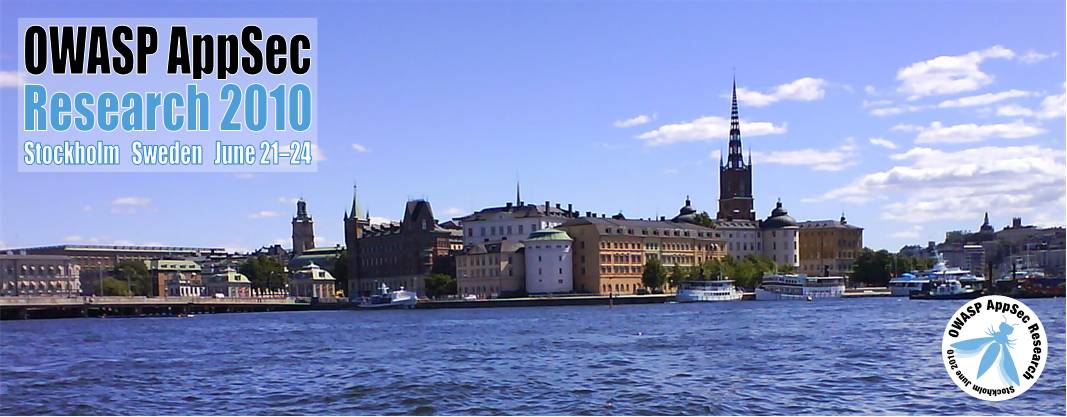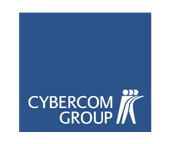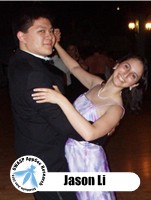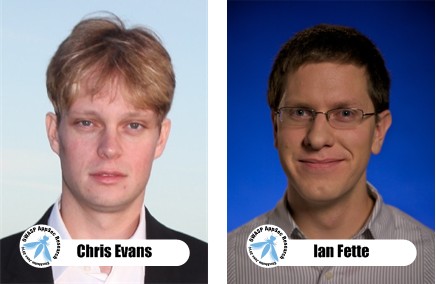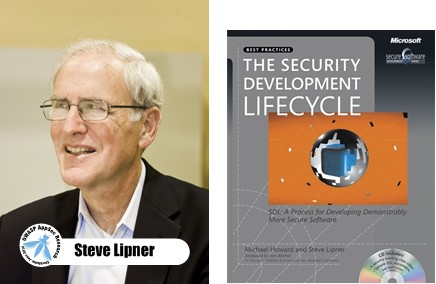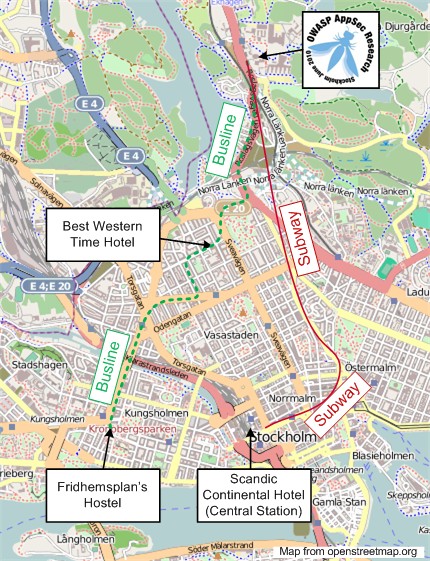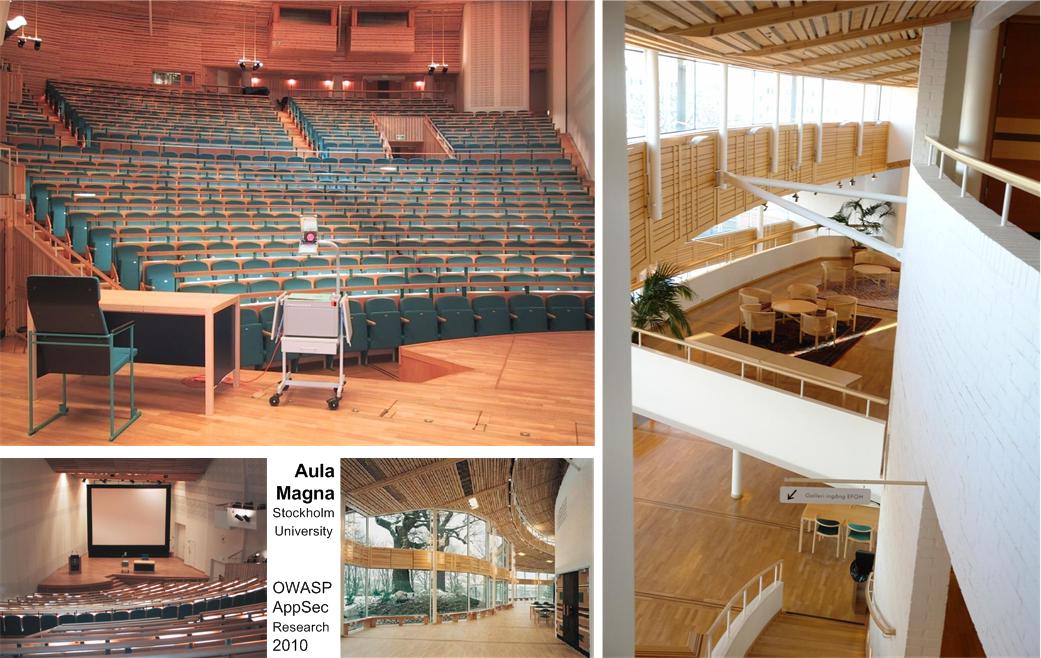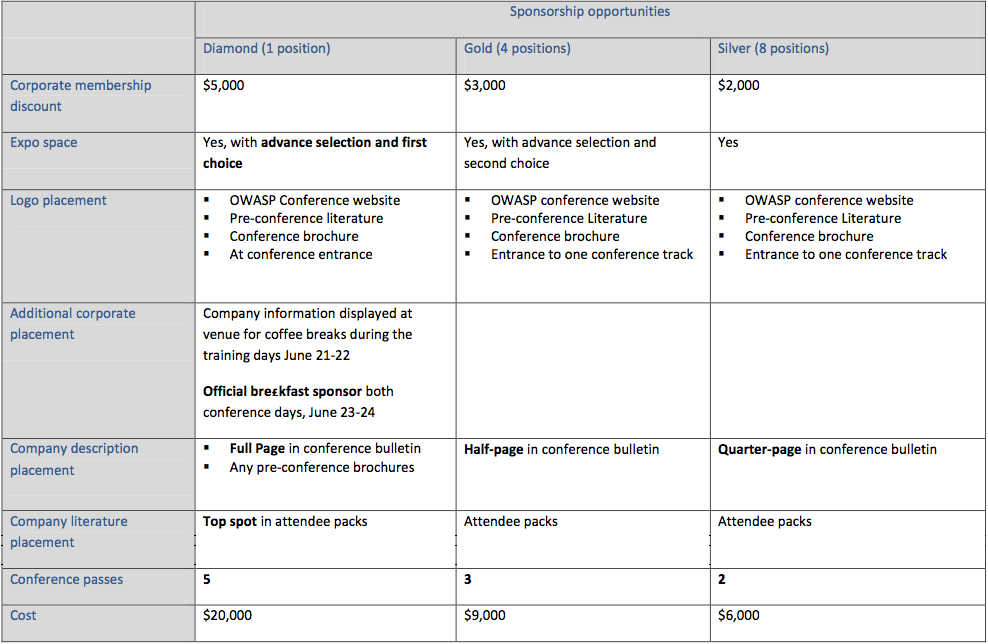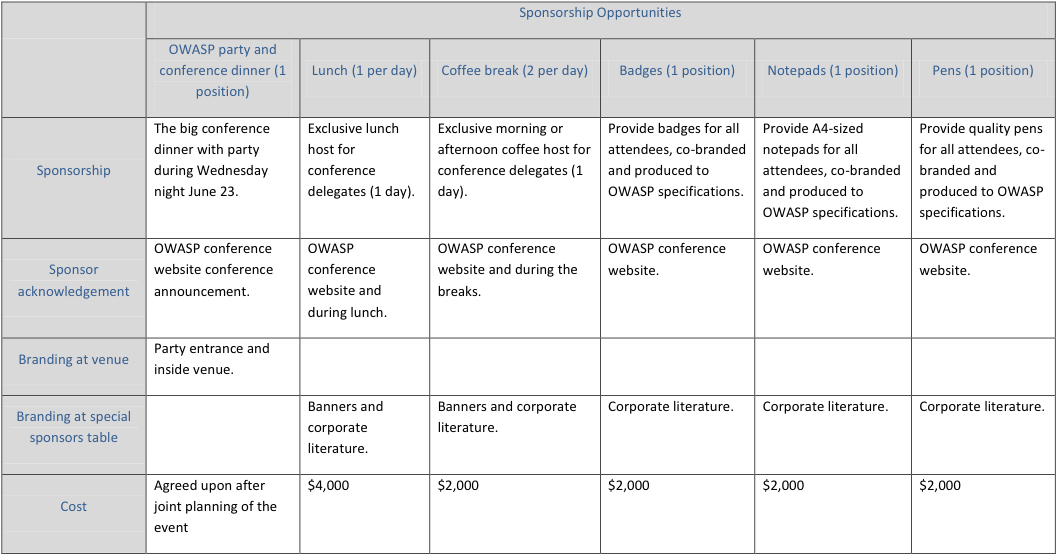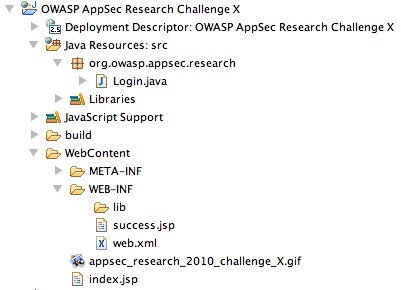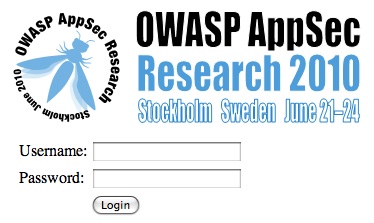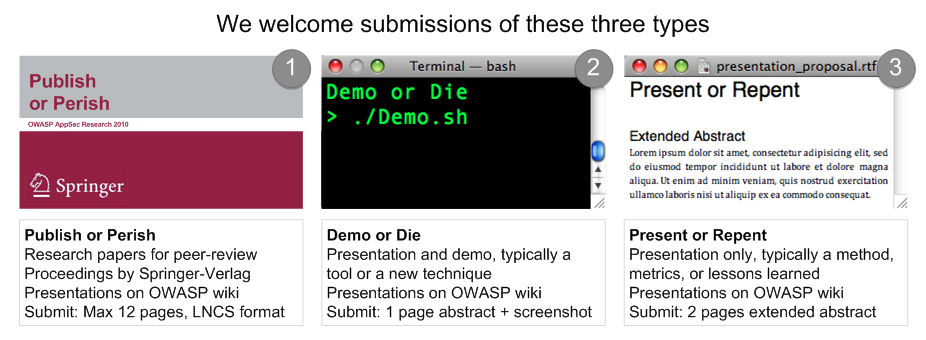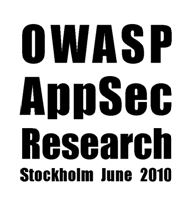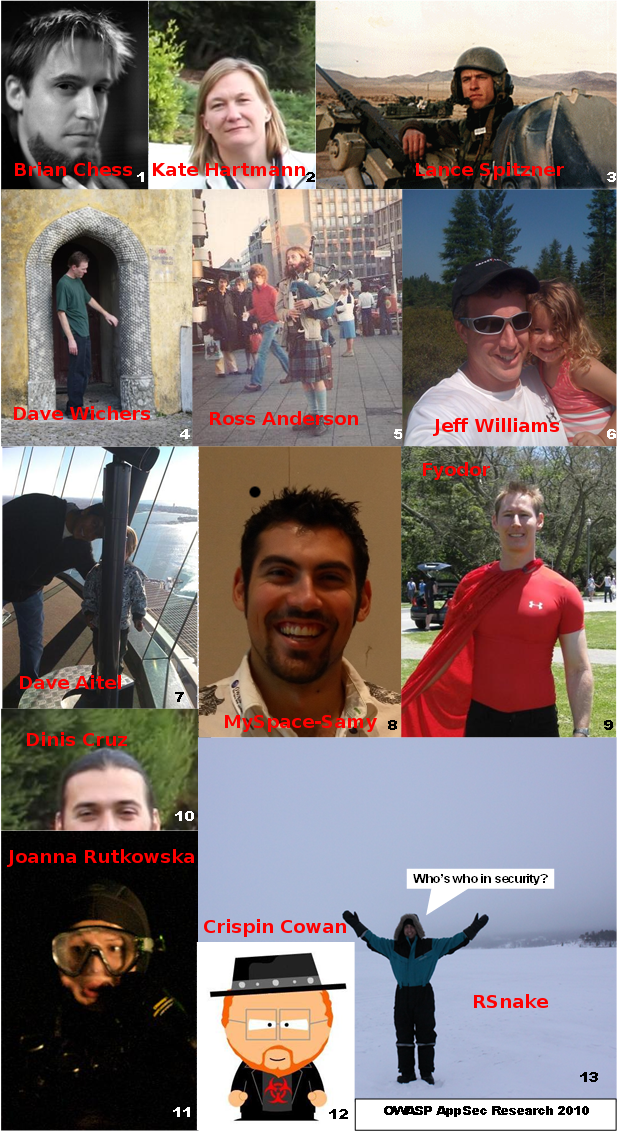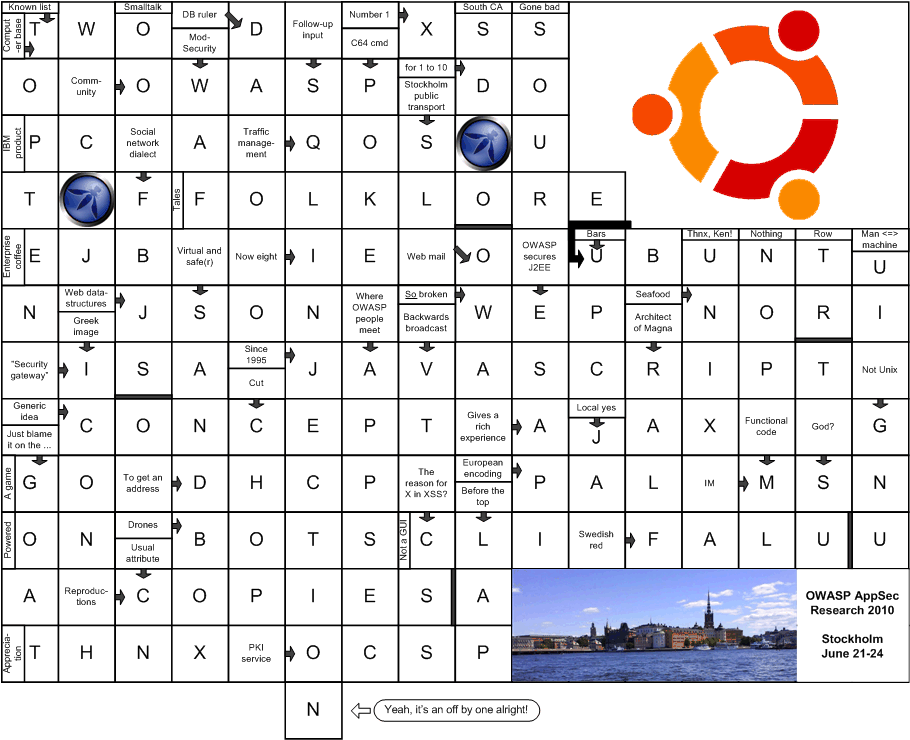This site is the archived OWASP Foundation Wiki and is no longer accepting Account Requests.
To view the new OWASP Foundation website, please visit https://owasp.org
OWASP AppSec Research 2010 - Stockholm, Sweden
Welcome
Invitation
Ladies and Gentlemen,
In June 21-24, 2010 let's all meet in beautiful Stockholm, Sweden. The OWASP chapters in Sweden, Norway, and Denmark hereby invite you to OWASP AppSec Research 2010.
If you have any questions, please email the conference chair: john.wilander at owasp.org
Sponsors
Silver sponsors (3 taken, 5 open):



Lunch sponsors (1 taken, 1 open):

Coffee break sponsors (1 taken, 3 open):

For full sponsoring program see the Sponsoring tab above.
"AppSec Research".equals("AppSec Europe")
This conference was formerly known as OWASP AppSec Europe. We have added 'Research' to highlight that we invite both industry and academia. All the regular AppSec Europe visitors and topics are welcome along with contributions from universities and research institutes.
This will be the European conference for anyone interested in or working with application security. Co-host is the Department of Computer and Systems Science at Stockholm University, offering a great venue in the fabulous Aula Magna.
Countdown Challenges -- Free Tickets to Win!
There will be a challenge posted on the conference wiki page the 21st every month up until the event. The winner will get free entrance to the conference. What are you waiting for? Go to the Challenges tab and have fun!
Organizing Committee
• John Wilander, chapter leader Sweden (chair)
• Mattias Bergling (vice chair)
• Alan Davidson, Stockholm University/Royal Institute of Technology (co-host)
• Ulf Munkedal, chapter leader Denmark
• Kåre Presttun, chapter leader Norway
• Stefan Pettersson (sponsoring coordinator)
• Carl-Johan Bostorp (schedule and event coordinator)
• Martin Holst Swende (coffee/lunch/dinner)
• Predrag Mitrovic, OWASP Sweden Board
• Kate Hartmann, OWASP
• Sebastien Deleersnyder, OWASP Board
Welcome to Stockholm this year!
Regards, John Wilander
June 21-22 (Training)
Training Registration is now OPEN
Application security training is given the first two days, June 21-22. The price is €990 (~$1.350) for a two-day course. Take the chance to learn from the best!
Course 1: Threat Modeling and Architecture Review (two days)
Pravir Chandra, Fortify Software
Abstract: Threat Modeling and Architecture Review are the cornerstones of a preventative approach to Application Security. By combining these topics into single comprehensive course attendees can get a complete understanding of how to understand the threat an application faces and how the application will handle those potential threats. This enables the risk to be accurately assessed and appropriate changes or mitigating controls recommended.
Trainer Bio: Pravir Chandra is Director of Strategic Services at Fortify where he works with clients to build and optimize software security assurance programs. Pravir is widely recognized in the industry for his expertise in software security and code analysis, and also for his ability to apply technical knowledge strategically from a business perspective. His book, Network Security with OpenSSL is a popular reference on protecting software applications through cryptography and secure communications. His varied special project experience includes creating and leading the Open Software Assurance Maturity Model (OpenSAMM) project
--> Register here
Course 2: Introduction to Malware Analysis (two days)
Jason Geffner, Next Generation Security Software (NGS), and Scott Lambert, Microsoft
Abstract: Security researchers are facing a growing problem in the complexity of malicious executables. While dynamic black-box automation tools exist to discover what malware will do on a given execution, it is often important for an analyst to know the full capabilities of a given malware sample. What port does it listen on? What password does it expect for backdoor access? What files will it write to? What will it do tomorrow that it didn't do today? This class will focus on teaching attendees the steps required to understand the functionality of given malware samples. This is a hands-on course. Attendees will work on real-world malware through a series of lab exercises designed to build their expertise in understanding the analysis process.
Learning Objectives:
- An understanding of how to use reverse engineering tools
- An understanding of low-level code and data flow
- PE File format
- x86 Assembly language
- API functions often used by malware
- Anti-analysis tricks and how to defeat them
- Exploits and Shellcode
- A methodology for analyzing malware with and without the use of specialized tools
Trainer Bio: Jason Geffner joined Next Generation Security Software Ltd. in June of 2007 as a Principal Security Consultant. Jason focuses on performing security reviews of source code and designs, reverse engineering software protection methods and DRM protection methods, deobfuscating and analyzing malware, penetration testing web applications and network infrastructures, and developing automated security analysis tools.
--> Register here
Course 3: Building Secure Ajax and Web 2.0 Applications (two days)
Dave Wichers, Aspect Security
Abstract: Students gain hands-on testing experience with freely available web application security test tools to find and diagnose flaws and learn how to identify them in their own projects. Because finding flaws is worthless without effective communication, the course also covers the process of creating and communicating software security flaws effectively. In addition, Aspect’s engineers are leaders in the AppSec Community and will offer the students an amazing perspective.
From the course outline:
CSS Attacks, Browser Add On Attacks, RSS / Data Feed Attacks, Microsoft Active X, Adobe Flash/Flex/AIR, Silverlight, Java FX, Ajax Mashups, Same Origin Policy, JavaScript, Web 2.0 CSRF Attacks, XHR JSON Forgery, Best Practice: Check HTTP Headers, Best Practice: Unique ID For XHR, JSON and XML Based XSS, How to use OWASP AntiSamy, Blended Threats, Dealing with Ajax Toolkits, Best Practice: Fuzzing ...
Trainer Bio: Dave Wichers is a member of the OWASP Board and a coauthor, along with Jeff Williams, of all previous versions of the OWASP Top Ten. Dave is also the Chief Operating Officer of Aspect Security, a company that specializes in application security services. Mr. Wichers brings over twenty years of experience in the information security field. Prior to cofounding Aspect, he ran the Application Security Services Group at a large data center company, Exodus Communications. His current work involves helping customers, from small e-commerce sites to Fortune 500 corporations and the U.S. Government, secure their applications by providing application security design, architecture, and SDLC support services: including code review, application penetration testing, security policy development, security consulting services, and developer training.
--> Register here
Course 4: Assessing and Exploiting Web Apps with Samurai-WTF (two days)
Justin Searle, InGuardians
Abstract: This course will focus on using open source tools to perform web application assessments. The course will take attendees through the process of application assessment using the open source tools included in the Samurai Web Testing Framework Live CD (Samurai-WTF). Day one will take students through the steps and open source tools used to assess applications for vulnerabilities. Day two will focus on the exploitation of web app vulnerabilities, spending half the day on server side attacks and the other half of the day on client side attacks. The latest tools and techniques will be use throughout the course, including several tools developed by the trainers themselves.
Trainer Bio: Justin Searle, a Senior Security Analyst with InGuardians, specializes in web application, network, and embedded penetration testing. Justin has presented at top security conferences including DEFCON, ToorCon, ShmooCon, and SANS. Justin has an MBA in International Technology and is CISSP and SANS GIAC-certified in incident handling and hacker techniques (GCIH) and intrusion analysis (GCIA). Justin is one of the founders and lead developers of Samurai-WTF.
--> Register here
Course 5: Securing Web Services (two days)
Jason Li, Aspect Security
Abstract: Aspect Security offers a one or two day course titled Securing Web Services designed to focus on the most important messages regarding the development and of secure web services. The objective for this course is to ensure that developers understand the real risks associated with Service Oriented Architectures, what standard are available to help, and how to use the standards. The course includes a combination of lecture and demonstration designed to provide detailed guidance regarding the implementation of specific security principles and functions.
Trainer Bio: Jason Li is a Senior Application Security Engineer for Aspect Security where he performs application security assessments and architecture reviews, as well as application security training, to a wide variety of financial and government customers. Jason is an active OWASP leader, contributing to several OWASP projects and serving on the OWASP Global Projects Committee. He holds a Post-Masters certificate in Computer Science and concentration in Information Security from Johns Hopkins University and a Masters degree in Computer Science from Cornell University.
--> Register here
June 23
| Conference Day 1 - June 23, 2010 | |||
|---|---|---|---|
| |
Track 1 | Track 2 | Track 3 |
| 08:00-08:50 | Registration and Coffee | ||
| 08:50-09:00 | Welcome to OWASP AppSec Research 2010 Conference (John Wilander & Dave Wichers) | ||
| 09:00-10:00 | Keynote: Cross-Domain Theft and the Future of Browser Security
Chris Evans, Information Security Engineer, and Ian Fette, Product Manager for Chrome Security, Google | ||
| 10:10-10:45 | BitFlip: Determine a Data's Signature Coverage from within the Application
Henrich Christopher Poehls |
CsFire: Browser Enforced Mitigation Against CSRF
Lieven Desmet and Philippe De Ryck |
Deconstructing ColdFusion
Chris Eng |
| 10:45-11:10 | Break - Expo | CTF Kick-Off | |
| 11:10-11:45 | Towards Building Secure Web Mashups
M Decat, P De Ryck, L Desmet, F Piessens, W Joosen |
Automated vs. Manual Security: You Can't Filter The Stupid David Byrne and Charles Henderson |
How to Render SSL Useless
Ivan Ristic |
| 11:55-12:30 |
Enterprise security patterns for RESTful Web Services Francois Lascelles |
Web Frameworks and How They Kill Traditional Security Scanning
Christian Hang |
The State of SSL in the World
Michael Boman |
| 12:30-13:45 | Lunch - Expo - CTF | ||
| 13:45-14:20 | Securing Web Applications with ESAPI
Ken Sipe |
Beyond the Same Origin Policy
Jasvir Nagra and Mike Samuel |
SymFileFuzzer - a New File Fuzzer Tool
Komal Randive |
| 14:30-15:05 | Security Toolbox for .NET Development and Testing
Johan Lindfors and Dag König |
Cross-Site Location Jacking (XSLJ) (not really)
David Lindsay and Eduardo Vela Nava |
Owning Oracle: Sessions and Credentials
Wendel G. Henrique and Steve Ocepek |
| 15:05-15:30 | Break - Expo - CTF | ||
| 15:30-16:05 | Value Objects a la Doman-Driven Security: A Design Mindset to Avoid SQL Injection and Cross-Site Scripting Vulnerabilities
Dan Bergh Johnsson |
New Insights into Clickjacking
Marco Balduzzi |
Session Fixation - the Forgotten Vulnerability?
Michael Schrank, Bastian Braun and Martin Johns |
| 16:15-17:00 | Panel Discussion: To Be Announced | ||
June 24
| Conference Day 2 - June 24, 2010 | |||
|---|---|---|---|
| Track 1 | Track 2 | Track 3 | |
| 09:00-10:00 | Keynote: The Security Development Lifecycle -- The Creation and Evolution of a Security Development Process Steve Lipner, Senior Director of Security Engineering Strategy, Microsoft Corporation | ||
| 10:10-10:45 |
Building Security In Maturity Model: A Review of Successful Software Security Programs in Europe Gabriele Giuseppini and Terri Randolph |
Promon TestSuite -- Client Based Penetration Testing Tool Folker den Braber and Tom Lysemose Hansen |
A Taint Mode for Python via a Library Juan José Conti and Alejandro Russo |
| 10:45-11:10 | Break - Expo - CTF | ||
| 11:10-11:45 |
Microsoft's Security Development Lifecycle for Agile Development Nick Coblentz |
Detecting and Protecting You Users from 100% of all Malware -- How? Bradley Anstis and Ellynora Nicoll |
OPA: Language Support for a Sane, Safe and Secure Web David Rajchenbach-Teller and François-Régis Sinot |
| 11:55-12:30 |
Secure Application Development for the Enterprise: Practical, Real-World Tips Michael Craigue |
Responsibility for the Harm and Risk of Software Security Flaws Cassio Goldschmidt |
Secure the Clones: Static Enforcement of Policies for Secure Object Copying Thomas Jensen and David Pichardie |
| 12:30-13:45 | Lunch - Expo - CTF | ||
| 13:45-14:20 |
Product Security Management in Agile Product Management Antti Vähä-Sipilä |
Hacking by Numbers Tom Brennan |
Safe Wrappers and Sane Policies for Self Protecting JavaScript Jonas Magazinius, Phu H. Phung and David Sands |
| 14:30-15:05 |
OWASP Top 10 2010 Dave Wichers |
Application Security Scoreboard in the Sky Chris Eng |
On the Privacy of File Sharing Services Nick Nikiforakis, Francesco Gadaleta, Yves Younan, and Wouter Joosen |
| 15:05-15:30 | Break - Expo - CTF | ||
| 15:30-16:00 | CTF Price Ceremony, Announcement of OWASP AppSec EU 2011, Closing Notes | ||
Invited Talks
"Cross-Domain Theft and the Future of Browser Security"
Chris Evans
Troublemaker, Information Security Engineer, and Tech Lead at Google inc.
Also the sole author of vsftpd.
Ian Fette
Product Manager for Chrome Security and Google's Anti-Malware initiative
Abstract
The web browser, and associated machinery, is on the front line of attacks. We will first look at design-level problems with the traditional browser in terms of monolithic architecture and fundamental problems with the same-origin policy. We will then look at the types of solution that are starting to appear in browsers such as Google Chrome and Internet Explorer. We will look at other important browser-based defenses such as Safe Browsing. We will detail what a future browser might look like that has a much more secure design, but is still usable on the wide variety of web sites that people use daily.
"The Security Development Lifecycle -- The Creation and Evolution of a Security Development Process"
Steve Lipner
Senior Director of Security Engineering Strategy, Trustworthy Computing Security, Microsoft Corporation.
Co-author of "The Security Development Lifecycle", Microsoft Press (book cover above).
Abstract
This keynote will review the evolution of the Security Development Lifecycle (SDL) from its origins in the Microsoft “security pushes” of 2002-3 through its current status and application in 2010. It will emphasize the aspects of change and change management as the SDL and its user community have matured and grown and will conclude with a summary of some recent changes and additions to the SDL. Specific topics to be addressed include:
- Motivations for introducing both the SDL and its predecessor processes.
- Considerations in selling the process to management and sustaining a mandate over a prolonged period.
- Scaling the SDL to an organization with tens of thousands of engineers.
- Managing change.
- The role of automation in the SDL.
- Adaptation of the SDL to agile development processes.
- Thoughts for organizations that are considering implementing the SDL.
The presentation will cover technical aspects of the SDL including a brief review of requirements and tools, and results.
Speaker Bio
Steven B. Lipner is senior director of Security Engineering Strategy at Microsoft Corp where he is responsible for programs that provide improved product security for Microsoft customers. Lipner leads Microsoft’s Security Development Lifecycle (SDL) team and is responsible for the definition of Microsoft’s SDL and for programs to make the SDL available to organizations beyond Microsoft. Lipner is also responsible for Microsoft’s corporate strategies related to government security evaluation of Microsoft products. Lipner joined Microsoft in 1999 and was initially responsible for the Microsoft Security Response Center. In the aftermath of the major computer “worm” incidents of 2001, Lipner and his team formulated and led programs that helped customers respond to the immediate challenges posed by software vulnerabilities and Internet worms. Lipner and his team also devised the strategy of “security pushes” that, as part of the Trustworthy Computing initiative, enabled Microsoft to make rapid improvements in the security of its software products and to change the corporate development culture to emphasize product security. The SDL is the product of these improvements, and is widely viewed as the industry’s leading secure software development process.
Before joining Microsoft, Lipner worked for a variety of software vendors and government contractors as a researcher, consultant, development manager and general manager in IT security. Many of the concepts whose development he led form the basis for today’s approaches to building secure systems. Some examples of these contributions include the application of virtual machine monitors (VMMs) as an approach to isolating security domains, and mathematical models for multilevel security.
Lipner is coauthor with Michael Howard of The Security Development Lifecycle (Microsoft Press, 2006) and is named as inventor on twelve U.S. patents and two pending applications in the field of computer and network security. He has authored numerous professional papers and conference presentations, and served on several National Research Council committees. He served two terms – a total of more than ten years – on the United States Information Security and Privacy Advisory Board and its predecessor. Lipner holds S.B. and S.M. degrees in Civil Engineering from the Massachusetts Institute of Technology and attended the Harvard Business School’s Program for Management Development.
Registration
Registration is now OPEN
Note: To save on processing expenses, all fees paid for the OWASP conference are non-refundable. OWASP can accommodate transfers of registrations from one person to another, if such an adjustment becomes necessary.
Stay Informed ... and Tell Others
Subscribe to the conference mailing list. This is the official information channel and you'll be the first to know about the program, invited speakers, opening of registration for training etc.
Add the event to your LinkedIn profle to tell all your business contacts that AppSec Research 2010 is the place to be.
Then get on the Twitter stream by using the tags #OWASP and #AppSecEU.
Conference Fees (June 23-24)
- Regular registration: €350
- OWASP individual member (not just chapter member): €300
- Full-time students*: €225
* We need some kind of proof of your full-time student status. Either ask your local OWASP chapter leader to vouch for you by email to [email protected], or email Kate a scanned image of your student ID (please compress the file size :).
Training Fee (June 21-22)
- Training fee is €990 for two days, see Training tab above
Travel & Hotels
Travel
Stockholm's foremost international airport is Arlanda (ARN). Clean and convenient speed trains will take you between Arlanda and Stockholm Central in 20 minutes. You can also fly to Stockholm Skavsta (NYO) or Stockholm Västerås (VST) where coaches take you to Stockholm Central in 1 h 20 min.
Accommodation
You can choose hotel/hostel freely in Stockholm but we provide three suggestions with pre-booked rooms. Before you book check with sites like hotels.com since they might have better prices for the very same hotels!
Subways and buses are convenient and safe and will take you right up to the venue (station/stop "Universitetet") from these three hotels:
Best Western Time Hotel
Why? Closest to the university, direct bus or subway to the conference
Best Western Time Hotel
Single room: 1395 SEK/€145/$195
Double room: 1575 SEK/€160/$220
Rooms pre-booked until May 6 under code "G#73641 OWASP"
Scandic Continental
Why? Right at the Central Station, convenient travel to and from airport, direct subway to the conference
Scandic Continental
Single room: 1590 SEK/€165/$220
Double room: 1690 SEK/€175/$235
Rooms pre-booked until early May under code "OWASP"
Fridhemsplan's Hostel
Why? Affordable stay in Stockholm's nicest hostel, direct bus to the conference
Fridhemsplan's Hostel
Rooms cost €35-€55 ($50-$80)
Booking via John Wilander ([email protected]). First-come-first-served with priority to students or people who have the need ;).
Venue
Sponsoring
We are now welcoming sponsors for OWASP AppSec Research 2010. Take the opportunity to support next year's major appsec event in Europe! The full sponsoring program is available as pdfs:
Sponsoring program in English: File:OWASP Sponsorship AppSec Research 2010 (eng).pdf
Sponsoring program in Swedish: File:OWASP Sponsorship AppSec Research 2010 (swe).pdf
Challenges
Countdown Challenges -- Free Tickets to Win!
There will be a challenge posted on the conference wiki page the 21st every month up until the event. The winner will get free entrance to the conference. Be sure to sign up for the conference mailing list to get a monthly reminder.
AppSec Research Challenge X: Build an Enterprise Java Rootkit
The tenth challenge is here!
Jeff Williams, chairman of OWASP, gave a very interesting talk at last year's Black Hat US and OWASP AppSec US -- "Enterprise Java Rootkits -- Hardly Anyone Watches the Developers". Now it's time for you to write a rootkit yourself, exploring Jeff's techniques and more.
The Project to Fool
Your assignment is to be the evil developer who implements and hides a backdoor in a Java servlet. We've implemented a very simple login web application and exported the Eclipse project (zip here). We will use this project to evaluate your submissions. It's a simple servlet/jsp project that we deployed on Tomcat 6.0. It even contains an evil output of user credentials to a temp file (not yet hidden though) to get you started. Screenshot from the app and the project structure:
Rules
- You must explain what your changes do (we need to evaluate your rootkit!)
- The original features + look and feel must be preserved
- Your additions should preferably look like security features such as IP whitelisting, logging, anti-CSRF, frequency blocking etc.
- You're only allowed to change the servlet (Login.java), and the gif image (appsec_research_challenge_X.gif)
- You do not have to use the jsps
- The original size of Login.java is 1,856 bytes and it mustn't grow to more than 4,000 bytes
- The gif image mustn't grow in size and should look close enough to the original to fool the committee
- Code should "look" readable, i e not minimized too heavily
How To Win
The organization committee will evaluate who has been able to hide the most evil stuff while complying to the rules. The more malicious functionality and the more clever disguise -- the more "points". All submissions must be posted as links or pasted code in this sla.ckers.org thread. Send an email to [email protected] when you post code or need attention. Deadline April 20.
Archive
Call for Papers and Proposals (closed)
1. Publish or Perish. Peer-reviewed 12 page papers to be published in formal proceedings by Springer-Verlag (Lecture Notes in Computer Science, LNCS). Presentation slides and video takes will be posted on the OWASP wiki after the conference.
2. Demo or Die. A demo proposal should consist of a pdf with a 1 page abstract summarizing the matter proposed by the speaker(s) and 1 page containing demo screenshot(s). Demos will have ordinary speaker slots but the speakers are expected to run a demo during the talk (live coding counts as a demo), not just a slideshow. Presentation slides and video takes will be posted on the OWASP wiki after the conference.
3. Present or Repent. A presentation proposal should consist of a 2 page extended abstract representing the essential matter proposed by the speaker(s). Presentation slides and video takes will be posted on the OWASP wiki after the conference.
If you have any questions regarding submissions etc, please email [email protected].
Topics of Interest
We encourage the publication and presentation of new tools, new methods, empirical data, novel ideas, and lessons learned in the following areas:
• Web application security
• Security aspects of new/emerging web technologies/paradigms (mashups, web 2.0, offline support, etc)
• Security in web services, REST, and service oriented architectures
• Security in cloud-based services
• Security of frameworks (Struts, Spring, ASP.Net MVC etc)
• New security features in platforms or languages
• Next-generation browser security
• Security for the mobile web
• Secure application development (methods, processes etc)
• Threat modeling of applications
• Vulnerability analysis (code review, pentest, static analysis etc)
• Countermeasures for application vulnerabilities
• Metrics for application security
• Application security awareness and education
Submission Deadline and Instructions
Update: Submission deadline for full-papers ("Publish or Perish") has been extended to March 7th 23:59 (Apia, Samoa time) due to numerous requests. Submit your paper to AppSec Research 2010 (EasyChair).
Full-paper submissions should be at most 12 pages long and must be in the Springer LNCS style for "Proceedings and Other Multiauthor Volumes". Templates for preparing papers in this style for LaTeX, Word, etc can be downloaded from: http://www.springer.com/computer/lncs?SGWID=0-164-7-72376-0. Full papers must be submitted in a form suitable for anonymous review: remove author names and affiliations from the title page, and avoid explicit self-referencing in the text.
Submission for "Demo or Die" and "Present or Repent" closed on February 7th.
Decision notification: April 7th
Program Committee (for review of full-papers)
• John Wilander, Omegapoint and Linköping University (chair)
• Alan Davidson, Stockholm University/Royal Institute of Technology (co-host)
• Lieven Desmet, Katholieke Universiteit Leuven
• Úlfar Erlingsson, Reykjavík University and Microsoft Research
• Martin Johns, University of Passau
• Christoph Kern, Google
• Engin Kirda, Institute Eurecom
• Ulf Lindqvist, SRI International
• Benjamin Livshits, Microsoft Research
• Sergio Maffeis, Imperial College London
• John Mitchell, Stanford University
• William Robertson, UC Berkeley
• Andrei Sabelfeld, Chalmers UT
Call for Training (closed)
(Info kept here for reference)
OWASP is currently soliciting training proposals for the OWASP AppSec Research 2010 Conference which will take place at Stockholm University in Sweden, on June 21st through June 24th 2010. There will be training courses on June 21st and 22nd followed by plenary sessions on the 23rd and 24th with three tracks per day.
We are seeking training proposals on the following topics (in no particular order):
- Security in Web 2.0, Web Services/XML
- Advanced penetration testing
- Static analysis for security
- Threat modeling of applications
- Secure coding practices
- Security in J2EE/.NET patterns and frameworks
- Application security with ESAPI
- OWASP tools in practice
We will look favourably on laboration-based/hands-on training.
Submission Deadline and Instructions
Submission deadline is Sunday February 7th 23:59 (Apia, Samoa time). To submit your training proposal please fill out the File:OWASP AppSec Research 2010 Call for Training.docx and email it to [email protected] with subject "AppSec Research 2010: Training proposal".
Upon acceptance you'll be requested to fill out the Training Instructor Agreement where you'll find details on revenue split etc. The agreement will be reworked but the previous one is here: File:Training Instructor Agreement.doc.
Upcoming List of Trainers on OWASP Wiki
As part of the OWASP Education Project, OWASP is starting an official list of trainers on the OWASP web site. This list (mentioning the trainer - course and contact details) will cover all trainers that performed training at OWASP conferences, together with their aggregated scores on the course feedback forms. Of course, this is opt-in. Please let us know if you are interested to participate in this program (tick the check-box on the application form).
AppSec Research Challenge 9: Crack 'Em Hashes (closed)
February's AppSec Research 2010 challenge is about breaking hashed passwords. It starts off easy with the old LM hash and ends with SHA256 and GOST3411.
How To Win
The first one to publish each broken password gets points according to the table below but at the same time helps the others since the password is the salt of the next hash. So you have to decide -- should you publish your cracked password and collect your points before the others or should you keep it a secret to get a head start cracking the next one? Deadline it March 21st.
To collect points for a password you must be the first one to publish that broken password on this sla.ckers.org thread. Please send an email to [email protected] at the same time so we can correct any misunderstandings. For instance we can happen to run into hash collisions, where someone finds another mixed alpha password of max 5 characters that concatenated with the right salt produces the same hash. In such a case we will publish the real password and give points to the one who found the collision.
The one with the most points on March 21st wins a free ticket to the conference!
Points to Earn
- pwd1 (LM) => 1 point
- pwd2 (MD2) => 3 points
- pwd3 (MD4) => 5 points
- pwd4 (MD5) => 9 points
- pwd5 (RIPEMD160) => 15 points
- pwd6 (SHA1) => 25 points
- pwd7 (SHA256) => 50 points
- pwd8 (GOST3411) => 100 points
The Hashes
Each password comprises of a-zA-Z (mixed alpha) and is max 5 characters long. With salt that means max 10 mixed alpha characters as input to the hash function. All hashes here are in hex format. The Java source code has all the details. The plus operator means string concatenation.
- LM(pwd1) 0C04DACA901299DBAAD3B435B51404EE
- MD2(pwd2 + pwd1) 16189F5462BF906E9D88CF6F152DE86F
- MD4(pwd3 + pwd2) FA8F46A6D347087D6980C3FA77DD4DE9
- MD5(pwd4 + pwd3) 425B33D6F60394C897B8413B5C185845
- RIPEMD160(pwd5 + pwd4) 35F34671D30472D403937820DCABC1C78C837071
- SHA1(pwd6 + pwd5) AE81A30510B2931921934218636B26A803330EB1
- SHA256(pwd7 + pwd6) B2FF0269E927C6559804A37590A0688C45DF143F85CEE0E3F239F846B65C9644
- GOST3411(pwd8 + pwd7) 16CC9F1FF65688E040F5ADA82A41A258FF948769CDA4C4A17D85228A6F358971
Example: Given that pwd1 is "Win" and pwd2 is "You", the hash 16189F5462BF906E9D88CF6F152DE86F is the result of MD2("YouWin"). Now pwd2 will be the salt when you crack pwd3.
The Source Code
The source code we've used to produce the hashes is available here zip. It's Java and all but the LM hash is done with Bouncy Castle 1.4.5.
AppSec Research Challenge 8: Construct an OWASP Polyglot (closed)
January's AppSec Research Challenge is to construct an OWASP polyglot, more specifically an OWASP logo that also can be run as JavaScript:
Show image: <img src="owasp_logo.gif">
Run script: <script src="owasp_logo.gif"></script>
Wikipedia says: "a polyglot is a computer program or script written in a valid form of multiple programming languages". This is about as cool as it gets :).
Rules
- Make your polyglot out of the regular OWASP logo in the upper left corner of this wiki (circle with the wasp).
- The file size must not grow.
- Pixel colors in the gif must not differ more than 5 in red, green, or blue. Ex: If a pixel originally had rgb 100,100,100 then 104,95,96 is OK.
- No malicious stuff of course
- When your polyglot is run as JavaScript it should execute as many of the following features as possible, starting from the top:
- alert(all cookies belonging to the current domain);
- alert(the last keystrokes on the keyboard every ten keystrokes);
- alert(the current time in Stockholm, once every minute);
- A quine. The polyglot outputs its own source code on the HTML page.
How to get started
Jasvir Nagra gave a talk on these kind of polyglots and published a gif/JavaScript polyglot on his blog. A good starting point is his gif file. Jasvir has also written an extensive article on gif/perl polyglots which explains how to get code into the gif file. Check out his guide.
How to win
Submit your entries in this sla.ckers.org thread. Either the first complete polyglot or the most complete polyglot wins. We will most probably provide you with a gif checker that validates the color differences. Check the thread.
AppSec Research Challenge 7: X-Mas Capture the Flag (closed)
It's the 21st and a new AppSec Research Challenge is posted.
Setting up the AppSec Research 2010 X-mas Challenge was a cooperative effort by the winner of AppSec Research Challenge 3, Mario Heiderich, and Martin Holst Swende. It is a multi-step challenge which involves finding a vulnerability in a web application and locating a hidden message. The winner gets free entrance to next year's conference. Start by subscribing to the conference mailing list. Then check the simple rules below and get going.
Rules:
- Please do not perform any resource-intensive tests, as the machine is pretty low-end and can be DoS:ed without much effort.
- The computer at the given IP address is the only system involved in this challenge, so please do not perform any tests of neighboring systems.
- Otherwise, you are free to hack away!
Challenge-page: 66.249.7.26
Discussions, QnA and reports about how far you have made it is welcome at the official sla.ckers thread.
Good luck and happy holidays! (And don't forget the submission deadline for the conference -- February 7)
AppSec Research Challenge 6: Design the Conference Logo (closed)
Note: This challenge is re-opened. Submit by February 21st.
November's AppSec Research 2010 Challenge asks you to design the conference logotype. So far we have used this:
... but would like something less "word processor-like".
How to win
- The logo should be suitable for both large printing and small web banners
- If you make a color logo, please submit a b/w version too
- "OWASP AppSec Research 2010" should in some way be part of the logo :)
Copyright?
By submitting your logo you agree to share it according to Creative Commons Attributions and that we credit you in the conference brochure and on the conference wiki but not in all places where we use the logo (i e we will not credit you on banners, sponsoring program, powerpoint presentations etc).
How to submit
Email jpg + svg to john.wilander [at] owasp.org before Monday December 14th 23:59 UTC. The creator of the best logo wins a free ticket to the AppSec Research 2010 conference!
AppSec Research Challenge 5: Graphical Effects (closed)
The October OWASP AppSec Research 2010 challenge is over. The winner of a free entrance ticket to next year's AppSec conference in Stockholm is "sirdarckcat" with FireworksIsNotABrowser_v4 (although we like the slightly oversized v6 better).
The challenge was about writing the coolest graphical effect in a 2010 character script.
An Example
As an example, copy the script below and paste the script over the URL in the URL bar.
javascript:R=0; x1=.1; y1=.05; x2=.25; y2=.24; x3=1.6; y3=.24; x4=300; y4=200; x5=300; y5=200; DI=document.getElementsByTagName("img"); DIL=DI.length; function A(){for(i=0; i-DIL; i++){DIS=DI[ i ].style; DIS.position='absolute'; DIS.left=(Math.sin(R*x1+i*x2+x3)*x4+x5)+"px"; DIS.top=(Math.cos(R*y1+i*y2+y3)*y4+y5)+"px"}R++}setInterval('A()',5); void(0)
As a simple teaser we give these png letters for the script to play with.
Rules
- The script should work in Firefox 3.5 (yeah, that means HTML5 and CSS3 :)
- Any resource, linked document, script, or image defined on the AppSec Research 2010 wiki page may be loaded/accessed/used
- No requests to any other location is allowed
- No obfuscation is allowed
- The script may only use ASCII
- Max length of the script is 2010 characters
- You have to give your effect an id and a version number (further explanation below)
- Any form of malicious code is of course banned ;)
How to Compete
There's an official thread on sla.ckers were you share your code and thoughts (Worried someone will steal you code? Check the originality bullet below). You can enter as many effects as you like but each effect has to have an id and a version number, e.g. JohnWobbler_v1.3 for version 1.3 of John's Wobbler effect. Deadline is November 14th, 23:59 UTC.
Choosing the Winner
Since this is a creative challenge the OC will choose the winner based on the following:
- Originality (tweaking someone's code is cool and encouraged but changing a few magic numbers or inverting a function won't make you the winner)
- Coolness (yeah, you need to convince a few Scandinavian people + Seba and Kate that your script is the coolest)
Either the OC will choose a winner by ourselves or we choose the top effects and let you guys vote for the winner.
AppSec Research Challenge 4: Who's Who in Security? (closed)
September's AppSec Research 2010 Challenge was to identify a number of people that are, in one way or another, known in the security business, by their picture. There were thirteen photos in total, portraiting thirteen different individuals.
The winner of a free ticket to the OWASP AppSec Research conference in 2010 was Thomas Vollstädt who submitted the correct solution just one day after the challenge was posted.
The Solution
The Names
Dinis Cruz, Gordon "Fyodor" Lyon, David Litchfield, Dave Aitel, Bruce Schneier, Dave Wichers, Gene Spafford, MafiaBoy, MySpace Samy, Tom Brennan, Halvar Flake, Alex Sotirov, Jeff Williams, Jennifer Granick, Kate Hartmann, Mudge, Lance Spitzner, Dan Kaminsky, Brian Chess, Joanna Rutkowska, Crispin Cowan, Michael Howard, Jay Beale, Ross Anderson, Dawn Song, Robert "rsnake" Hansen, and Solar Designer.
The Pictures
If you'd like to see the original pictures without the names, here's the link: [[1]]
AppSec Research Challenge 3: Non-Alphanumeric JavaScript (closed)
The August AppSec Research 2010 Challenge was to create a JavaScript alert("owasp") that pops up the word 'owasp', case-insensitive, without using any alphanumeric characters (0-9a-zA-Z). There was a tremendous activity and we want to thank everyone who participated. The size of the final result was almost a third of the first entry (see chart below). Want to check out the winning snippet by .mario? Enter the following in the Firebug console: ω=[[Ṫ,Ŕ,,É,,Á,Ĺ,Ś,,,Ó,Ḃ]=!''+[!{}]+{}][Ś+Ó+Ŕ+Ṫ],ω()[Á+Ĺ+É+Ŕ+Ṫ](Ó+ω()[Ḃ+Ṫ+Ó+Á]('Á«)'))
It is based on a few different ideas. First of all, a variable assignment on the form
[a,b,c,,e]="abcde" // a="a", c="c",e="e"
Which is performed on the string "truefalse[object Object]"
[Ṫ,Ŕ,,É,,Á,Ĺ,Ś,,,Ó,Ḃ]=!''+[!{}]+{}] // right-hand side is "truefalse[object Object]"
Also, the following construction obtains the window.sort-function, which leaks the window-object when called without arguments :
ω=[]["sort"] //ω is now window.sort
Therefore, calling ω()["alert"] invokes window.alert. To generate the string "owasp", the string "wasp" can be obtained by calling btoa on the characters "Á«)".
This was really a great team effort, and I think a lot of us learned some new tricks. The final winner was .mario. Congratulations!
JavaScript Without Alphanumeric Characters?
It is possible to write valid javascript completely without alphannumeric characters (0-9a-zA-Z). To produce a number, you can instead use for example an empty string, '', interpret it as a boolean with a bang: !'' -- which leads to the boolean object true. true, interpreted as a numeric value, equals one. Thus,
$ = +!''; // $ === 1
$++;$++; // $ === 3
In a similar fashion, strings can be created from strings embedded in the language. The boolean object true can be converted to string by concatenation, and then accessed by numeric index to, for example, produce the letter 'e' :
â = (!''+'')[$] // â[$] === "true"[3] === e
Previous Similar Contest
These two techniques are behind a previous contest at the forum "sla.ckers.org", where the contest was to create alert(1) with as few non-alphanumeric characters as possible. Currently, the code actually being executed was:
([],"sort")()["alert"](1) // since ([],"sort")() leaks window object in FF, ==> window["alert"](1) is called, which is another form of window.alert(1)
The winner, or at least current leading entry is 84 bytes long, and looks like this:
(Å='',[Į=!(ĩ=!Å+Å)+{}][Į[Š=ĩ[++Å]+ĩ[Å-Å],Č=Å-~Å]+Į[Č+Č]+Š])()[Į[Å]+Į[Å+Å]+ĩ[Č]+Š](Å)
The Challenge
August's challenge was to, in a similar fashion, create an alert("owasp"), case-insensitive, not using any alphanumeric characters. The shortest working code snippet submitted by September 18th 23:59:59 UTC won a free ticket. By "working" we meant JavaScript that executes in Firefox/Firebug, not depending on any Firebug DOM variables for execution.
Submissions were made as comments to the challenge 3 blogpost on Owasp Sweden. Check it out.
AppSec Research Challenge 2: OWASP Crossword Puzzle (closed)
July's crossword challenge is over. Many permutations arrived in our inbox but it was tricky to get it completely right. Congratulations to Johannes Dahse and Johan Nilsson who in the end were allowed to join forces to be able to find the correct solution. They win a 50 % conference ticket discount each.
You find the solution below.
AppSec Research Challenge 1: Input Validation and Regular Expressions (closed)
This challenge is over. The winner was Partik Nordlén. To see the solution(s), please visit the appsec_eu_2010 mailing list archive.
Some people, when confronted with a problem, think “I know, I'll use regular expressions.” Now they have two problems.
--Jamie Zawinski, in comp.emacs.xemacs
The 21st of each month up until the conference in June 2010 we'll have a countdown challenge posted here. The winner each month will get a free entrance ticket worth about €300/$400. Be sure to sign up for the conference mailing list to get a monthly reminder.
The Challenge
A community is hosted on a very large domain, yahoogle.com. The users of that community all have profiles, where they are allowed to use basic HTML for customization, as well as JavaScript files hosted on the domain.
All the code for the profile pages are filtered on the server side, and whenever a piece of code containing "<script..." is encountered, the following regular expression is used to validate that the script loaded is hosted on a subdomain of yahoogle.com:
.*(<script){1}([^>]+)src=('http:\/\/[a-zA-Z]+.yahoogle.com\/scripts\/[0-9A-Za-z]+\.js').*\/>
Capture group 3 is then also checked against a whitelist of allowed scripts on that domain. The whitelist consists of "http://secure.yahoogle.com" and "http://scripts.yahoogle.com".
Your task is to formulate a snippet of HTML that goes correctly through the filter and the whitelist, but loads the script "http://insecure.com/evil.js" instead. Also, rework the regular expression to defend against your "attack".
Email your solution to Martin Holst Swende <[email protected]>. The first correct answer wins a free ticket to the conference. The free ticket is personal and the judgement of the organizing committee can not be overruled :).
